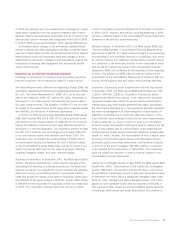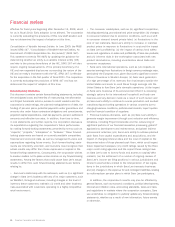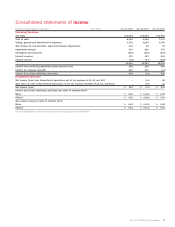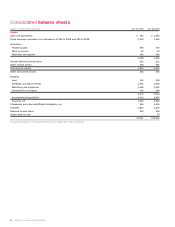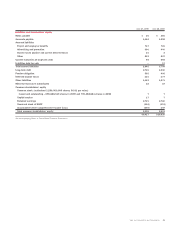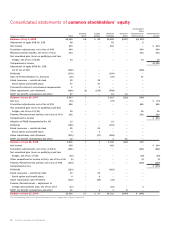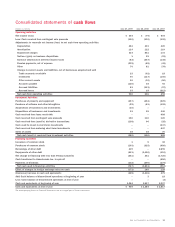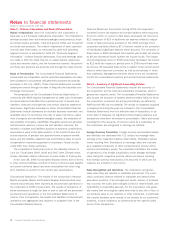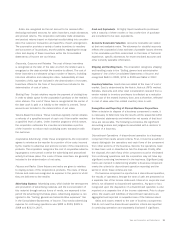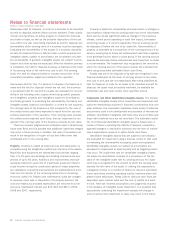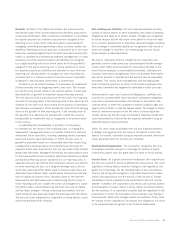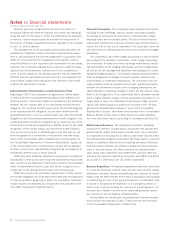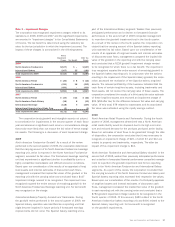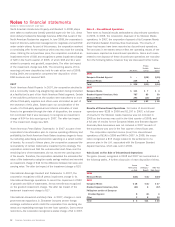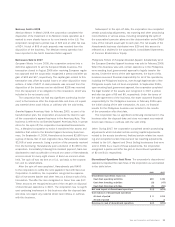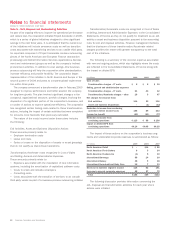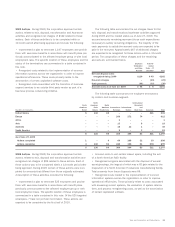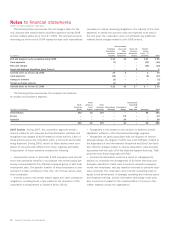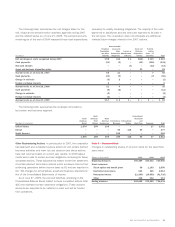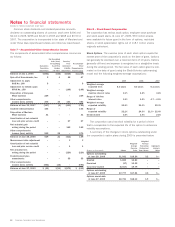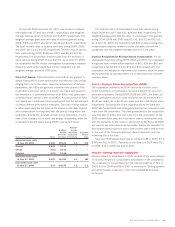Sara Lee 2009 Annual Report Download - page 57
Download and view the complete annual report
Please find page 57 of the 2009 Sara Lee annual report below. You can navigate through the pages in the report by either clicking on the pages listed below, or by using the keyword search tool below to find specific information within the annual report.Goodwill Goodwill is the difference between the purchase price
and the fair value of the assets acquired and liabilities assumed in
a business combination. When a business combination is completed,
the assets acquired and liabilities assumed are assigned to the
reporting unit or units of the corporation given responsibility for
managing, controlling and generating returns on these assets and
liabilities. Reporting units are business components at or one level
below the operating segment level for which discrete financial infor-
mation is available and reviewed by segment management. In many
instances, all of the acquired assets and liabilities are assigned
to a single reporting unit and in these cases all of the goodwill is
assigned to the same reporting unit. In those situations in which
the acquired assets and liabilities are allocated to more than one
reporting unit, the goodwill to be assigned to each reporting unit
is determined in a manner similar to how the amount of goodwill
recognized in the business combination is determined.
Goodwill is not amortized; however, it is assessed for impairment
at least annually and as triggering events may occur. The corpora-
tion performs its annual review in the second quarter of each year.
Recoverability of goodwill is evaluated using a two-step process.
The first step involves a comparison of the fair value of a reporting
unit with its carrying value. If the carrying value of the reporting unit
exceeds its fair value, the second step of the process is necessary
and involves a comparison of the implied fair value and the carrying
value of the goodwill of that reporting unit. If the carrying value of
the goodwill of a reporting unit exceeds the implied fair value of
that goodwill, an impairment loss is recognized in an amount equal
to the excess.
In evaluating the recoverability of goodwill, it is necessary
to estimate the fair values of the reporting units. In making this
assessment, management relies on a number of factors to discount
anticipated future cash flows, including operating results, business
plans and present value techniques. In 2009, the fair value of
goodwill is estimated based on a discounted cash flow model using
management’s business plans and projections as the basis for
expected future cash flows for the first ten years and a 2% residual
growth rate thereafter. Management believes the assumptions used
for the impairment test are consistent with those utilized by a market
participant performing similar valuations for our reporting units. A
separate discount rate derived from published sources was utilized
for each reporting unit and, on a weighted average basis, the dis-
count rate used was 8.9%. Rates used to discount cash flows are
dependent upon interest rates, market-based risk premium and the
cost of capital at a point in time. Because some of the inherent
assumptions and estimates used in determining the fair value of
these reporting units are outside the control of management, includ-
ing interest rates, market-based risk premium, the cost of capital,
and tax rates, changes in these underlying assumptions and our
credit rating can also adversely impact the business units’ fair values.
The amount of any impairment is dependent on these factors, which
cannot be predicted with certainty.
Exit and Disposal Activities Exit and disposal activities primarily
consist of various actions to sever employees, exit certain contractual
obligations and dispose of certain assets. Charges are recognized
for these actions at their fair value in the period in which the liabil-
ity is incurred. Adjustments to previously recorded charges resulting
from a change in estimated liability are recognized in the period in
which the change is identified. Our methodology used to record
these charges is described below.
Severance
Severance actions initiated by the corporation are
generally covered under previously communicated benefit arrange-
ments under GAAP, which provides for termination benefits in the
event that an employee is involuntarily terminated. Liabilities are
recorded under these arrangements when it is probable that employ-
ees will be entitled to benefits and the amount can be reasonably
estimated. This occurs when management with the appropriate
level of authority approves an action to terminate employees who
have been identified and targeted for termination within one year.
Noncancelable Lease and Contractual Obligations
Liabilities are
incurred for noncancelable lease and other contractual obligations
when the corporation terminates the contract in accordance with
contract terms or when the corporation ceases using the right con-
veyed by the contract or exits the leased space. The charge for these
items is determined based on the fair value of remaining lease
rentals reduced by the fair value of estimated sublease rentals that
could reasonably be obtained for the property, estimated using an
expected present value technique.
Other
For other costs associated with exit and disposal activities,
a charge is recognized at its fair value in the period in which the
liability is incurred, estimated using an expected present value tech-
nique, generally when the services are rendered.
Stock-Based Compensation The corporation recognizes the cost
of employee services received in exchange for awards of equity
instruments based upon the grant date fair value of those awards.
Income Taxes As a global commercial enterprise, the corporation’s
tax rate from period to period is affected by many factors. The most
significant of these factors includes changes in tax legislation, the
global mix of earnings, the tax characteristics of the corporation’s
income, the timing and recognition of goodwill impairments, acqui -
sitions and dispositions and the portion of the income of foreign
subsidiaries that is expected to be repatriated to the U.S. and be
taxable. In addition, the corporation’s tax returns are routinely audited
and finalization of issues raised in these audits sometimes affects
the tax provision. It is reasonably possible that tax legislation in the
jurisdictions in which the corporation does business may change in
future periods. While such changes cannot be predicted, if they occur,
the impact on the corporation’s tax assets and obligations will need
to be measured and recognized in the financial statements.
Sara Lee Corporation and Subsidiaries 55


